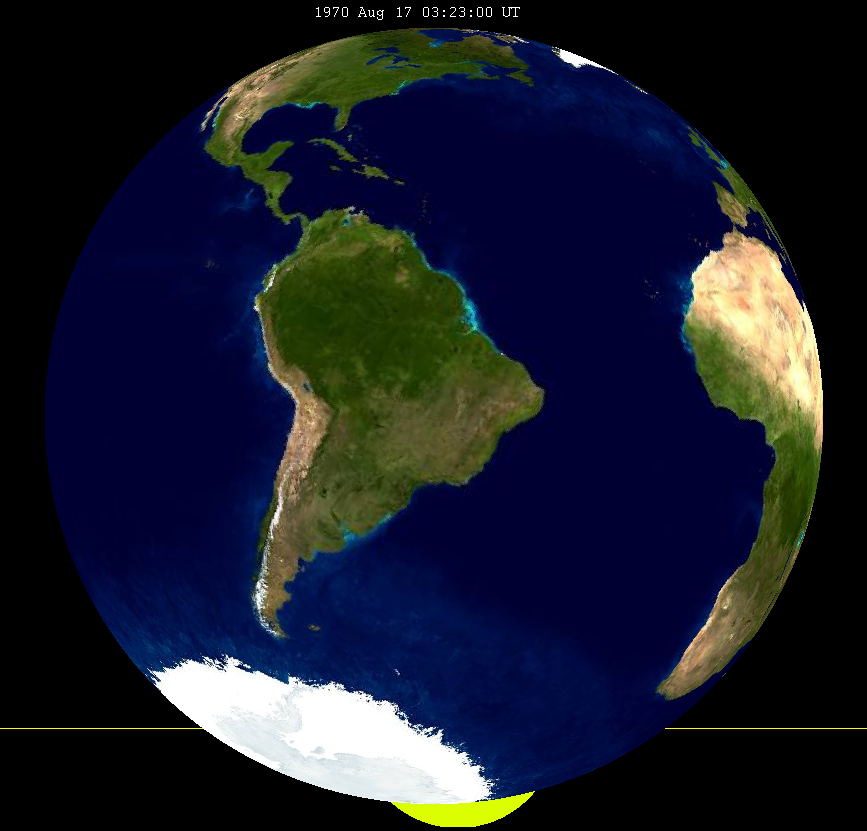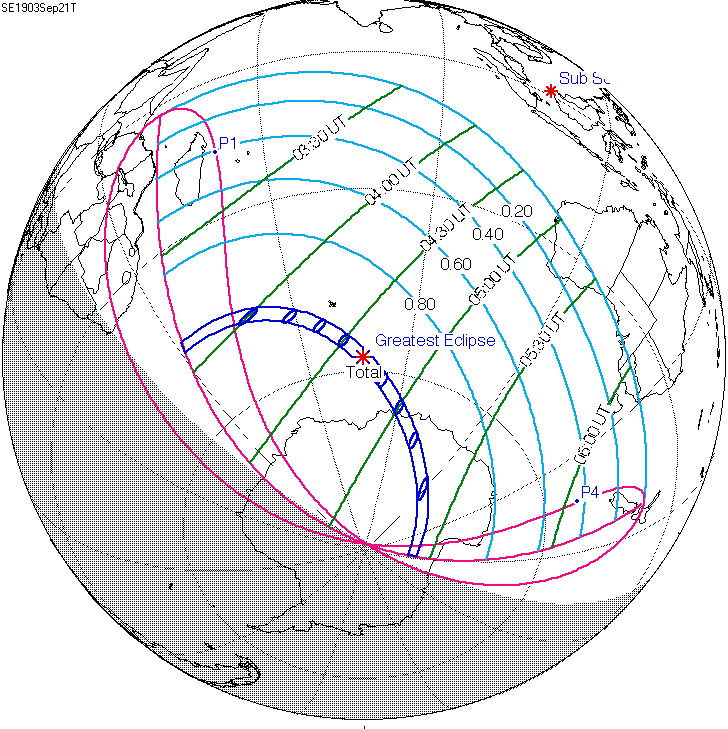|
July 1981 Lunar Eclipse
A partial lunar eclipse took place on Friday, July 17, 1981, the second of two lunar eclipses in 1981. The Earth's shadow on the Moon was clearly visible in this eclipse, with 55% of the Moon in shadow; the partial eclipse lasted for 2 hours and 43 minutes. Visibility The partial phase of this lunar eclipse was visible in southeastern North America, South America, western Africa, seen rising over northern North America, and setting over Western Europe and Eastern Africa. Related lunar eclipses Eclipses in 1981 * A penumbral lunar eclipse on Tuesday, 20 January 1981. * An annular solar eclipse on Wednesday, 4 February 1981. * A partial lunar eclipse on Friday, 17 July 1981. * A total solar eclipse on Friday, 31 July 1981. Lunar year series Saros series It was part of Saros series 119. Half-Saros cycle A lunar eclipse will be preceded and followed by solar eclipses by 9 years and 5.5 days (a half saros).Mathematical Astronomy Morsels, Jean Meeus, p.110, Chapter ... [...More Info...] [...Related Items...] OR: [Wikipedia] [Google] [Baidu] |
Lunar Eclipse
A lunar eclipse occurs when the Moon moves into the Earth's shadow. Such alignment occurs during an eclipse season, approximately every six months, during the full moon phase, when the Moon's orbital plane is closest to the plane of the Earth's orbit. This can occur only when the Sun, Earth, and Moon are exactly or very closely aligned (in syzygy) with Earth between the other two, which can happen only on the night of a full moon when the Moon is near either lunar node. The type and length of a lunar eclipse depend on the Moon's proximity to the lunar node. When the moon is totally eclipsed by the Earth, it takes on a reddish color that is caused by the planet when it completely blocks direct sunlight from reaching the Moon surface, as only the light reflected from the lunar surface has been refracted by Earth's atmosphere. This light appears reddish due to the Rayleigh scattering of blue light, the same reason sunrise and sunsets are more orange than during the day. Un ... [...More Info...] [...Related Items...] OR: [Wikipedia] [Google] [Baidu] |
List Of 20th-century Lunar Eclipses
A total of 229 lunar eclipses took place in the 20th century: 83 penumbral, 65 partial and 81 total. See also: Lists of lunar eclipses, List of 19th-century lunar eclipses and List of 21st-century lunar eclipses List Eclipses from 2001 to 2002 are included on the end to complete the final set. References This list was compiled with data calculated by Fred Espenak of NASA's GSFC. {{DEFAULTSORT:20th-century lunar eclipses Lunar eclipses Lunar eclipses A lunar eclipse occurs when the Moon moves into the Earth's shadow. Such alignment occurs during an eclipse season, approximately every six months, during the full moon phase, when the Moon's orbital plane is closest to the plane of the Earth ... Lunar eclipses by time ... [...More Info...] [...Related Items...] OR: [Wikipedia] [Google] [Baidu] |
List Of Lunar Eclipses
There are several lists of lunar eclipses On the Moon, by the Earth ; Type * List of central lunar eclipses * Total penumbral lunar eclipse ; Classification * List of saros series for lunar eclipses * Tetrad (astronomy) contains lists of tetrads in the late-20th and 21st centuries ; By era * Lunar eclipses by century * Historically significant lunar eclipses Historically significant lunar eclipses are eclipses of the Moon that are mentioned in historical accounts in connection with a significant event. Lunar eclipses are somewhat rare events, although not as rare as solar eclipses, because unlike sol ... On Earth, by the Moon {{DEFAULTSORT:Lunar eclipses ... [...More Info...] [...Related Items...] OR: [Wikipedia] [Google] [Baidu] |
August 1988 Lunar Eclipse
A partial lunar eclipse took place on Saturday, August 27, 1988, the second of two lunar eclipses in 1988, the first being on March 3, 1988. The Earth's shadow on the Moon was clearly visible in this eclipse, with 29.159% of the Moon in shadow; the partial eclipse lasted for 1 hour, 52 minutes and 59.7 seconds. The Moon was only 5 hours and 48 minutes before perigee (Perigee on Saturday, August 27, 1988 at 04:53 p.m. UTC or 16:53), making it 6.3% larger than average Visibility Relations to other lunar eclipses Eclipses of 1988 * A penumbral lunar eclipse on March 3. * A total solar eclipse on March 18. * A partial lunar eclipse on August 27. * An annular solar eclipse on September 11. Saros series This eclipse is part of Saros cycle series 118. Lunar year series Metonic cycle (19 years) Half-Saros cycle A lunar eclipse will be preceded and followed by solar eclipses by 9 years and 5.5 days (a half saros).Mathematical Astronomy Morsels, Jean Meeus, p.110, Ch ... [...More Info...] [...Related Items...] OR: [Wikipedia] [Google] [Baidu] |
June 1974 Lunar Eclipse
A partial lunar eclipse took place on Tuesday, June 4, 1974, the first of two lunar eclipses in 1974. The Moon was strikingly shadowed in this deep partial eclipse which lasted 3 hours, 13 minutes and 37.1 seconds, with 82.695% of the Moon in darkness at maximum. The Moon was 4.5 days before apogee (Apogee on Sunday, June 9, 1974), making it 4.4% smaller than average. Visibility It was completely visible over South America, Europe, Africa, central Asia, Australia, seen rising over North Altantic Ocean and South America, and setting over Asia and west in Australia. Related lunar eclipses Saros series It was part of Saros series 120. Half-Saros cycle A lunar eclipse will be preceded and followed by solar eclipses by 9 years and 5.5 days (a half saros).Mathematical Astronomy Morsels, Jean Meeus, p.110, Chapter 18, ''The half-saros'' This lunar eclipse is related to two total solar eclipses of Solar Saros 127. Eclipses in 1974 * A partial lunar eclipse on Tuesday, 4 June ... [...More Info...] [...Related Items...] OR: [Wikipedia] [Google] [Baidu] |
June 1992 Lunar Eclipse
A partial lunar eclipse took place on Monday, June 15, 1992, the first of two lunar eclipses in 1992, the second being with a total lunar eclipse on Wednesday, December 9. Visibility Related eclipses Eclipses of 1992 * An annular solar eclipse (ascending node) on January 4. * A partial lunar eclipse (ascending node) on June 15. * A total solar eclipse (descending node) on June 30. * A total lunar eclipse (descending node) on December 9. * A partial solar eclipse (ascending node) on December 24. Lunar year series Half-Saros cycle A lunar eclipse will be preceded and followed by solar eclipses by 9 years and 5.5 days (a half saros).Mathematical Astronomy Morsels, Jean Meeus, p.110, Chapter 18, ''The half-saros'' This lunar eclipse is related to two total solar eclipses of Solar Saros 127. Tritos series * Preceded: Lunar eclipse of July 17, 1981 * Followed: Lunar eclipse of May 16, 2003 Tzolkinex * Preceded: Lunar eclipse of May 4, 1985 * Followed: Lunar ... [...More Info...] [...Related Items...] OR: [Wikipedia] [Google] [Baidu] |
August 1970 Lunar Eclipse
A partial lunar eclipse took place on Monday, August 17, 1970, the second of two lunar eclipses in 1970, the first was on February 21 of that year. The Earth's shadow on the Moon was clearly visible in this eclipse, with 41% of the Moon in shadow; the partial eclipse lasted for 2 hours and 11 minutes. It was the second of two lunar eclipses in 1970. More details about the Partial Lunar Eclipse of 17 August 1970. Penumbral Magnitude: 1.35215 Umbral Magnitude: 0.40797 Gamma: -0.80534 Date: Monday, 17 August 1970 Saros Series: 118th (49 of 73) Greatest Eclipse: 1970 August 17 at 03:23:25.6 UTC Sun Right Ascension: 9.74 Sun Declination: 13.6 Sun Diameter: 1895.8 arc-seconds Moon Right Ascension: 21.77 Moon Declination: -14.3 Moon Diameter: 2007.8 arc-seconds The total duration of the eclipse was 4 hours, 31 minutes. The duration of the partial eclipse was 2 hours, 11 minutes. Visibility Relation to other lunar eclipses Lunar year series Metonic cycle This is the thir ... [...More Info...] [...Related Items...] OR: [Wikipedia] [Google] [Baidu] |
Lunar Eclipse From Moon-1981Jul17
Lunar most commonly means "of or relating to the Moon". Lunar may also refer to: Arts and entertainment * ''Lunar'' (series), a series of video games * "Lunar" (song), by David Guetta * "Lunar", a song by Priestess from the 2009 album ''Prior to the Fire'' * Lunars, a fictional race in the series ''The Lunar Chronicles'' by Marissa Meyer Other uses * Lunar Magic, Super Mario World level editor * Lunar Design, or LUNAR, a San Francisco-based design consultancy * Hasselblad Lunar, a digital camera * Lunar, a brandname of Ethinylestradiol/cyproterone acetate, a birth control pill * Lunar C (Jake Brook, born 1990), English rapper See also * * * Lunar calendar, based upon the monthly cycles of the Moon's phase ** Lunar day, in such calendars ** Lunar month, in such calendars * Moon (other) * Luna (other) Luna commonly refers to: * Earth's Moon, named "Luna" in Latin * Luna (goddess), the ancient Roman personification of the Moon Luna may also refer to: Places ... [...More Info...] [...Related Items...] OR: [Wikipedia] [Google] [Baidu] |
Solar Eclipse Of July 22, 1990
A total solar eclipse occurred on July 22, 1990. A solar eclipse occurs when the Moon passes between Earth and the Sun, thereby totally or partly obscuring the image of the Sun for a viewer on Earth. A total solar eclipse occurs when the Moon's apparent diameter is larger than the Sun's, blocking all direct sunlight, turning day into darkness. Totality occurs in a narrow path across Earth's surface, with the partial solar eclipse visible over a surrounding region thousands of kilometres wide. Totality was visible in southern Finland, the Soviet Union (including today's northern Estonia and northern Russia), and eastern Andreanof Islands and Amukta of Alaska. In Finland the solar eclipse occurred during sunrise and enabled observation and photography without protective glasses, which was however hampered by strong clouds. The Sun was totally eclipsed in Helsinki Helsinki ( or ; ; sv, Helsingfors, ) is the Capital city, capital, primate city, primate, and List of cities and ... [...More Info...] [...Related Items...] OR: [Wikipedia] [Google] [Baidu] |







